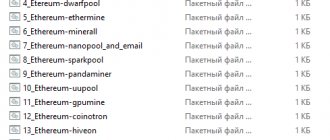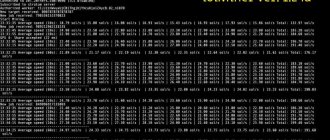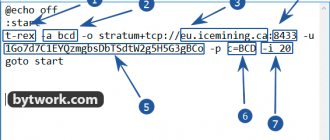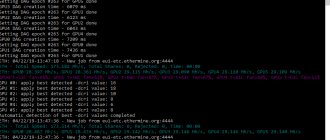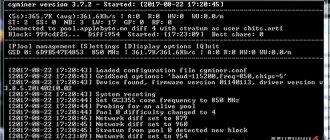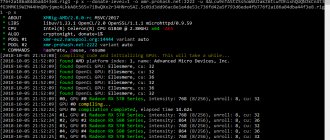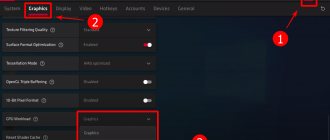DOWNLOAD:
When we talk about Cryptonote (Cryptonight) for AMD GPUs, we prefer the SRBMiner miner due to the large number of supported options and features, however there is a good competitor called JCE miner Cryptonote CPU + GPU . JCE miner is a closed source software available as a binary for Windows only (for GPU) and with a 0.9% dev fee for GPUs (separate CPU miner has a higher fee, a version is available for this Linux). In terms of performance, the JCE miner is pretty much on par with the fastest alternatives like SRBminer , sometimes it can be a little faster, sometimes a little slower, depending on the algorithm and settings. For example, our latest experience shows slightly better performance for TUBE mining using JCE compared to SRB 1.7.5 on an RX 580. The JCE miner does support a lot of Cryptonothe (Cryptonight) variants, so you can use it for pretty much all the popular variants . There is support for both SSL and NiceHash extraction functionality.
Quick setup of a batch file
In order to start mining we need to create or edit a file with a .bat extension. Specify the following commands in it:
- SRBMiner-MULTI.exe - command to launch the SRBMiner application
- —algorithm randomx — specify the algorithm for mining
- —pool xmr-eu1.nanopool.org — specify the pool address
- 14444 — specify the pool port
- —wallet 44tLjmXrQNrWJ5NBsEj2R77ZBEgDa3fEe9GLpSf2FRmhexPvfYDUAB7EXX1Hdb3aMQ9FLqdJ56yaAhiXoRsceGJCRS3Jxkn.5d3c802ee0f8e12e4eb9792722b7816a42178aa 29ef7477c138ddb940c55648d indicate coin purse + after the dot. The wallet can be obtained either from , or you can install a Monero cold wallet.
- —gpu-target-temperature 70 — the program will strive to maintain this temperature
- —gpu-off-temperature 83 — the miner will turn off when this temperature is reached and turn on when it drops
- —send-stales — send outdated shares to the pool (some pools partially pay for them or award bonuses).
- —enable-restart-on-rejected — automatically restart the miner if there are too many rejected shares
Sample batch file:
setx GPU_MAX_HEAP_SIZE 100setx GPU_MAX_USE_SYNC_OBJECTS 1setx GPU_MAX_ALLOC_PERCENT 100setx GPU_MAX_SINGLE_ALLOC_PERCENT offcd %~dp0clsset LOGTIME=%date:~10.4%_%date:~4.2%_%date:~7.2%_%time:~0.2%_ %time:~3.2%set LOGTIME=%LOGTIME: =%set LOGTIME=%LOGTIME:,=.%.txtSRBMiner-MULTI.exe --algorithm randomx --pool xmr-eu1.nanopool.org:14444 --wallet 44tLjmXrQNrWJ5NBsEj2R77ZBEgDa3fEe9GLpSf2FRmhexP vfYDUAB7EXX1Hdb3aMQ9FLqdJ56yaAhiXoRsceGJCRS3Jxkn. 5d3c802ee0f8e12e4eb9792722b7816a42178aa29ef7477c138ddb940c55648d.rig1pause
The program is launched as usual, by double-clicking on the file with the .bat extension
After launching the program, we will see the following window:
We wrote in the batch file only those commands that will help you connect to the pool and start the process of mining cryptocurrency. However, to improve performance, you may need to configure some other command line arguments, depending on your hardware type.
Bottom line
We can recommend this program to all miners, regardless of experience in cryptocurrency mining. Nanominer delivers good performance, and thanks to constant updates, the hashrate is getting larger and stability is improving. Through the application, you can adjust the core and memory frequency of video cards from both manufacturers, which further increases your income.
At the same time, a beginner will not have to deal with an abundance of settings, since everything can be used immediately after downloading nanominer. The developer's commission is competitive, which is also good news for 2022 miners. A good program with decent functionality, which we recommend for use.
All command line arguments
Pool connection settings:
--pool url:port pool address: port
--wallet address user's wallet address
--password value pool password
--tls value to use TLS (true or false)
--nicehash value force use nicehash (true or false)
--job-timeout value specify the time, if no jobs were received during this period, the miner will restore the connection. Disabled by default
--max-difficulty value specify a decimal number, if the pool difficulty is higher than this value the miner will reconnect to the pool
--start-block-height value specify the number when to start mining if a certain block height is reached. The pool should send this information
—algo-min-time value specify the time used with the ability to switch algorithms, the minimum time for mining the same algorithm. Default 10 min.
—keepalive value send a command to the pool that the miner is working so that the connection does not break (true or false, not every pool supports this)
—algorithm value algorithm for mining
--retry-time value specify the time to wait before trying to reconnect to the pool
—send-stales send shares that the miner considers stale to the pool
--give-up-limit value how many times to try to connect to a pool before switching to the next pool
—main-pool-reconnect value time, how often to try to reconnect to the main pool.
Default 10 minutes Performance and intensity settings:
--cpu-priority value specify the priority of the miner process (1-5), where 5 is the highest
--cpu-threads how many CPU threads to use for mining
--cpu-affinity value specify thread affinity bitmask
--disable-cpu-optimisations use only SSE2 for mining on video cards (SSE2 is a set of instructions that determines the capabilities of a particular processor)
--disable-huge-pages disable use of the "Lock pages in memory" option - not recommended
--disable-hw-aes use only AES for CPU mining (AES is a CPU instruction set)
--disable-numa disable binding to numa nodes (“Uneven memory access”)
--disable-tweaking disable video card settings options that are enabled by default
--set-compute-mode put AMD video cards into compute mode and disable crossfire (run as administrator)
Video card performance settings:
--reset-vega disable/enable Vega video cards when starting the miner
--gpu-intensity value specify the intensity of the video card (1-31) values separated by commas
--gpu-raw-intensity value use raw intensity for extra performance, values separated by commas
--gpu-threads value specify the number of video card threads, values separated by commas
—gpu-worksize value indicate the worksize of the video card, values separated by commas
Temperature and fan settings:
—gpu-target-temperature value indicate the temperature of the video card, values separated by commas. The miner will try to maintain the specified temperature on all found video cards
--gpu-off-temperature value specify the temperature for turning off the video card, values separated by commas
—gpu-target-fan-speed value specify the speed of the video card fan in rpm, values separated by commas
Select devices:
—gpu-id value specify the identifier of the video card from --list-devices, values separated by commas
--disable-cpu disable mining on the processor
—disable-gpu disable mining on the video card
--list-devices display (list of available video cards, ordered by busid)
Watchdog (reboot) settings:
--disable-gpu-watchdog disable detection of video card failures
--gpu-watchdog-disable-mode if enabled, the watchdog will try to disable frozen video cards instead of restarting the miner
--reboot-script-gpu-watchdog filename, if set, disables the built-in restart procedure when video cards fail and runs this script instead
—watchdog-rounds value specify how many rounds to consider (round 30 seconds) for gpu-watchdog to be called. Default - 5
--disable-startup-monitor disable the watchdog timer for the miner startup interval
—enable-restart-on-rejected Enable automatic restart of the miner if there are too many rejected shares. Installed with --max-rejected-shares
—max-rejected-shares value maximum number of rejected shares allowed in the connection. Defaults to 20 if --enable-restart-on-rejected is enabled
—max-no-share-sent value time, if the pool does not accept shares for x times, restarts the miner [default 0 - disabled]
--shutdown-temperature value if this temperature is reached, the miner will shut down the system (ADL must be enabled
—max-startup-time value specify the time, the maximum time for starting video cards and starting mining. Default 2 minutes
--startup-script filename run your own script when the miner starts - set overclocking, voltage, etc.
Error log file settings:
--extended-log enable more informative logging
--gpu-errors-alert value notify when the number of calculation errors for any video card reaches this value [default 0 - disabled]
--log-file filename enable logging to file
Configuration files:
--config-file filename use a configuration file other than config.txt
--pools-file filename use a pool file other than pools.txt
—setup start interactive mode to create basic configuration files
Other settings:
—adl-disable disable ADL (ADL is a library for accessing driver functionality for AMD video cards)
—background run the miner in the background, without a console window
this console window can be disabled
—enable-workers-ramp-up allow workers to start slowly
--forced-shutdown never release resources on reboot/shutdown
--list-algorithms display a list of available algorithms
--max-startup-time-script filename run script if maxstartuptime is exceeded
--disable-extranonce-subscribe do not send data "mining.extranonce.subscribe" to the pool
--gpu-adl-type value specify ADL to use (1 or 2), values separated by commas
—gpu-tweak-profile value specify the number of optimization profiles from 0 to 10, 0 disables the
setting API settings:
—api-enable enable API for statistics
--api-port value specify the port on which the statistics API is available (default 21550)
--api-rig-name value specify the name of your rig rig in the statistics API
--api-rig-restart-url value specify the URL available in the browser (starts the computer restart
--api-miner-restart-url value define the URL available in the browser, causes the miner to restart
--api-rig-shutdown-url value define the URL that, when accessed in the browser, causes the computer to shut down
Setting up configuration files
In the archive with the program you will find examples of configuration files, configured .bat files and instructions in Russian.
Program files
Configuration options in the config.txt file
"algorithm" specify the algorithm specify the intensity (1-31), if set to 0, the miner will try to find the best settings (intensity, worksize, threads)
"raw_intensity" specify the number of global threads, use if you want to fine-tune the intensity
"worksize" specify the size of the local workgroup
"threads" specify the number of video card threads to use
“giveup_limit” specify the number of times to try to connect to the pool before switching to the next pool from the pool.txt file. If set to 0, the miner will exit and will not retry the connection.
"timeout" specify the time when the connection to the pool is considered expired
"retry_time" specify the time how long to wait before trying to reconnect to the pool
"reboot_script_gpu_watchdog" specify a file name for the script in the miner directory, if set, disables the built-in procedure for restarting the miner when the video card fails and instead runs the script you specify
"main_pool_reconnect" specify the time (minimum 3 minutes or 180 seconds) how often to try to reconnect to the main pool. Default is 10 minutes.
“target_temperature” specify the temperature from 0 to 99. The miner will try to maintain the specified temperature on all found video cards (ADL must be enabled, only works on cards that support OverdriveN)
“shutdown_temperature” specify the temperature from 0 to 100, if this temperature is reached, the miner will shut down the system (ADL must be enabled)
“off_temperature” specify the temperature in degrees C when to turn off the video card if it reaches this value. After the value is 15, the card turns on automatically again
"tweak_profile" specify a profile (0-10) that applies settings to video cards that can increase hashrate. 0 - no tweaks, 10 - max. If you add L after the number, it will use low settings (eg "4L")
Configuration parameters in pools.txt
"pool" address: pool port
"wallet" your wallet
"password" your password
"nicehash" true or false, set to true if you are using Nicehash
“job_timeout” specify the number in seconds, if during this period no jobs were received from the pool, then the miner will reconnect to the pool (disabled by default)
"max_difficulty" specify a decimal number, if the difficulty of the pool is higher than this value, the miner will reconnect to the pool
"pool_use_tls" true or false, if true, then the miner will use the SSL/TLS protocol to connect to the pool
"algorithm" specify an algorithm to inform the miner what algorithm the pool is using (--list-algorithms)
"start_block_height" specify a number to start mining when a certain block height is reached. The pool should send this information
“algo_min_time” indicate the time used with the ability to switch algorithms (the minimum time for mining the same algorithm). Default 10 min.
"keepalive" true or false, not every pool supports this
Video card configuration in the config.txt file
“id” indicate the identifier of the video card, it can be found with the --list-devices parameter
"intensity" indicate the intensity (1-31), if set to 0, the miner will try to find the best settings (intensity, worksize, threads)
"raw_intensity" specify the number of global threads, use if you want to fine-tune the intensity
"worksize" specify the size of the local workgroup
"threads" specify the number of GPU threads to use
"tweak_profile" specify a profile (0-10) that applies settings to video cards that can increase hashrate. 0 - no tweaks, 10 - max. If you add L after the number, it will use low settings (eg "4L")
“target_temperature” specify the temperature from 0 to 99. The miner will try to maintain the specified temperature on all found video cards (ADL must be enabled, only works on cards that support OverdriveN)
“target_fan_speed” specify the fan speed value (0-6000), the miner will try to set the fan speed on video cards to this value. Value in RPM (number of rounds per minute) (ADL must be enabled)
“off_temperature” specify the temperature in degrees C when to turn off the video card if it reaches this value. The card will be turned on again when the temperature drops
"adl_type" specify the ADL type (1-3), 1 - USE FOR OVERDRIVEN, 2 - USE FOR OVERDRIVE5, 3 - USE FOR OVERDRIVE8. Defaults to 1 if not set. Option 2 (Overdrive5) is suitable for older cards, 3 for Radeon VII and newer
Example:
"gpu_conf" : [{ "id" : 0, "intensity" : 20, "worksize" : 256, "threads" : 1},{ "id" : 1, "intensity" : 20, "worksize" : 256, "threads" : 1},{ "id" : 2, "intensity" : 15, "worksize" : 64, "threads" : 2},{ "id" : 3, "intensity" : 15, "worksize" : 64, "threads": 2}]
Installation of mining on the processor
If you do not set the --cpu-threads or --cpu-affinity options, the miner will automatically try to find the optimal settings for your system.
Sometimes automatic tuning doesn't find the optimal settings, so you have to experiment to find it.
You need to set the number of threads (--cpu-threads) and bind them to the appropriate processor using the --cpu-affinity command.
Mask calculator here: https://bitsum.com/tools/cpu-affinity-calculator/
Examples
4 CORE/8 THREADS PROCESSOR:
1. Use 4 threads, 1 on each core: : --cpu-threads 4 --cpu-affinity 0x55
2. Use 8 threads, 2 on each core: : --cpu-threads 8 --cpu-affinity 0xFF
6 CORE/12 THREADS PROCESSOR:
1. Use 6 threads, 1 on each core: : --cpu-threads 6 --cpu-affinity 0x555
2. Use 12 threads, 2 on each core: : --cpu-threads 12 --cpu-affinity 0xFFF
Algorithm switching capabilities
The miner supports two types of algorithm switching:
- user-defined algorithm in the pools configuration file (pools.txt)
- algorithm switch initiated on the pool side
To enable the ability to switch algorithms, rename the file 'algorithms_example.txt' to 'algorithms.txt'.
1. The user himself determines in the pool configuration file which algorithm the pool uses.
Pools for multiple coins/algorithms can be defined in the same config file, and when a manual switchover/automatic switchover occurs when a pool fails, the miner will restart with the settings for the next pool.
Example:
pools.txt:
{"pools" :[ {"pool" : "loki.herominers.com:10111", "wallet" : "LWC57bMh2uvQX62DT9eLkr2JvsTbeGKrcbwocNk6nAD2DXQsy4p6CJMV8zze6SYnzo2XHsdsmaDaP8Rc6JceP4WSTkRnjJF", "password" : "x","algorithm": "randomxl"},{"pool" : "xmr-eu1.nanopool.org:14444", "wallet" : "4A5hJyu2FvuM2azexYssHW2odrNCNWVqLLmzCowrA57xGJLNufXfzVgcMpAy3YWpzZSAPALhVH4Ed7xo6RZYyw2bUtbm12g", "password" : "x" algorithm": "randomx"}]}
The miner will start mining using the randomxl algorithm. If the user changes the pool manually or there is a failover to the next pool, SRBMiner-MULTI will connect to the next pool (in this example nanopool) using
configuration settings for the randomx algorithm, which are read from the algorithms.txt file
2. Pools such as MoneroOcean can initiate automatic algorithm switching based on profitability. You can read how it works on their page (https://moneroocean.stream/#/help/faq)
Example:
There is already a pool configuration file for MoneroOcean supplied with SRBMiner-MULTI. You can find it in the Pools\pools-monero-ocean.txt folder. Change the wallet address to your own.
If the algorithm is supported in SRBMiner-MULTI and also in MoneroOcean (you can see what algorithms they support here: https://moneroocean.stream/#/coins), it can be used to switch algorithms.
You can find the file 'start-mining-monero-ocean.bat' which uses the Pools\pools-monero-ocean.txt configuration file where you previously changed the wallet address.
If you do not want to include every algorithm supported by the miner in the algorithm switching process, you will need to edit the algorithms.txt file to suit your needs.
algorithms.txt file:
This is where you define individual settings for each algorithm.
Enable the algorithms that will be available during the algorithm switching process.
Teams:
“algorithm” name of the algorithm [run the miner with the --list-algorithms command to see the available ones]
config" path to the configuration file to use in this algorithm path to the startup script you want to run when you start the miner
“hashrate” is the hashrate of your system using this algorithm. Only used with pool side algorithm switch
Example:
{"algorithms" :[{"algorithm" : "randomx","config" : "Config\\config-randomx.txt","startup_script": "","hashrate" : 1400},{"algorithm" : " randomxl","config" : "Config\\config-randomxl.txt","startup_script": "","hashrate" : 1450}]}
Driver requirements
In order to work with NVIDIA nanominer GPUs, you need Nvidia driver 410.48 and later on Linux or 411.31 and later on Windows. The nanominer cuda11 version requires Nvidia driver 455.23 and later on Linux or 456.38 and later on Windows. Nvidia 30xx series GPUs will only work with the cuda11 version of the miner.
Nanominer is a software product developed by nanopool to create cryptocurrency units based on the following algorithms:
| Algo | Coin | Dev Fee (once per 2 hours) | AMD | Nvidia | CPU |
| Ethash | ETH & others | 1% | ✓ | ✓ | |
| Etchash | ETC | 1% | ✓ | ✓ | |
| Ubqhash | UBQ | 1% | ✓ | ✓ | |
| KawPow | RVN | 2% | ✓ | ✓ | |
| Octopus | CFX | 2% | ✓ | ||
| Autolykos | ERG | 2.5% | ✓ | ✓ | |
| RandomX | XMR | 2% | ✓ | ||
| Verushash | VRSC | 2% | ✓ |
nanominer also supports Zilliqa mining in current configurations (see example configurations):
| Configuration | Merged (same pool) | Split (different pools) |
| ETH+ZIL | ✓ | ✓ |
| ETC+ZIL | ✓ | ✓ |
| CFX+ZIL | ✓ | |
| ERG+ZIL | ✓ | |
| RVN+ZIL | ✓ | |
| When mining Zilliqa on a different pool, nanominer will use a placeholder 0xffffffffffffffffffffffffffffffffffffffff ETH/ETC address to authorize on Zilliqa pool. |
Web statistics with GUI
You must first enable the API using the --api-enable command in the start.bat file
web statistics
Set the name of your rig (computer) using --api-rig-name rig_name is also set in start.bat
Once you have launched the miner, you can access the statistics page in your browser:
https://127.0.0.1:21550/stats
There are also three other options that can help you reboot the miner, shutdown or reboot your rig remotely:
--api-rig-restart-url
This must be a unique string that, when accessed in a browser, causes the computer to restart. The miner must have administrator rights.
--api-rig-shutdown-url
This must be a unique string that, when accessed in the browser, causes the computer to shut down. The miner must have administrator rights.
--api-miner-restart-url
This should be a unique string that is accessed in the browser when SRBMiner-MULTI is restarted
Example:
SRBMiner-MULTI.exe --config-file Config\config-randomxl.txt --pools-file Pools\pools.txt --api-enable --api-rig-restart-url 12345fff --api-rig-shutdown-url 54321fff --api- miner-restart-url restart_my_srb
Visiting this URL restarts your farm:
https://127.0.0.1:21550/12345fff
Visiting this URL shuts down your farm:
https://127.0.0.1:21550/54321fff
Visiting this URL restarts SRBMiner-MULTI:
https://127.0.0.1:21550/restart_my_srb
Speed
It's hard to compare GPU Miners. There are a lot of external parameters: the card itself, its memory, the biosmod, the drivers, the overclocking, the Power Limit…
However, according to the first feedbacks, here's the status on CN-v7:
- JCE is faster than any other miner on small RX cards (RX550 and RX560). They are my favorite cards, and the ones I use on most of my rigs.
- JCE is always faster than the Wolf0-based miners (Stak, Xmrig, Gateless...). This is not fair since I can read their code and they cannot read mine, but it's a proof JCE is not a copy-paste of their code.
- JCE is surprisingly fast on Vega, reaching 2050+ on Vega 64 on CN-v7.
- JCE is close to SRB and Claymore otherwise, sometimes slightly above, sometimes slightly below.
- I got mixed results on HD7800. I measured higher hashrate than other miners on my rig, but got opposite comments from some users. To be tested.
- JCE is bad on small 1G cards compared to the legendary Claymore 9.7, but this miner is no longer supported.
On CN-v8:
- Still always better than the open-source miners (Stak, Xmrig, Gateless...).
- Claymore is just no longer compatible.
- JCE is the best on older cards like HD6000 and HD7000 and R7/R9 series
- RX560 cards reach 500+, 850+ on R9 290/X, RX570/580 cards reach 1000+
- 420+ on HD7850 2G
- 480+ on HD7950 3G
Setting the background mode
Background mode means that the miner will work without a console window. Both CPU and GPU miners can run in the background.
The SRBMiner-MULTI process can be found in the task manager if you want to stop/disable a process running in the background.
Example:
Run CPU mining in the background (no console window) using 3 CPU threads
SRBMiner-MULTI.exe --algorithm k12 --pool your-pool-here --wallet YOUR_WALLET --cpu-threads 3 --disable-gpu --background
Examples of using
1. Disable mining on the processor, use only mining on video cards
SRBMiner-MULTI.exe --algorithm keccak --pool your-pool-here --wallet your-wallet-here --disable-cpu
2. Run the miner in the background without a console window, with the API enabled on port 17644 (https://127.0.0.1:17644)
SRBMiner-MULTI.exe --algorithm keccak --pool your-pool-here --wallet your-wallet-here --background --api-enable --api-port 17644
3. Disable GPU mining, use 7 CPU threads with extended event logging enabled and saving it in the Logs\log.txt file
SRBMiner-MULTI.exe --algorithm keccak --pool your-pool-here --wallet your-wallet-here --disable-gpu --cpu-threads 7 --log-file Logs\log.txt --extended-log
4. Complete example for mining on CPU and GPU only from the batch file (using 4 GPUs / and 7 CPU threads on the K12 algorithm)
SRBMiner-MULTI.exe --algorithm k12 --gpu-id 0,1,2,3 --gpu-intensity 26,25,26,26 --gpu-worksize 256,256,256,256 --gpu-threads 1,1,1,1 --cpu-threads 7 —pool your-pool-here —YOUR_WALLET
5. Disable GPU mining, use 15 CPU threads with extended event logging enabled and saving it in the Logs\log.txt file, start Randomx mining from block height 1978433 and run the miner in the background.
SRBMiner-MULTI.exe --algorithm randomx --pool your-pool-here --wallet your-wallet-here --disable-gpu --cpu-threads 15 --log-file Logs\log.txt --extended-log --background --start-block -height 1978433
Best known configurations
- HD7950 (Tahiti 3GB and more) Cryptonight v7
{ "mode" : "GPU", "worksize" : 8, "alpha" : 64, "beta" : 8, "index" : ..., "multi_hash":464 }, { "mode" : "GPU", " worksize" : 8, "alpha" : 64, "beta" : 8, "index" : ..., "multi_hash":464 },
Twice the same to use the double-mem mode.
- HD7950 (Tahiti 3GB and more) Cryptonight-Heavy/Haven/Tube
{ "mode" : "GPU", "worksize" : 8, "alpha" : 64, "beta" : 8, "index" : ..., "multi_hash":656 },
Double-mem should be avoided here
- HD7790 (Bonaire 1GB) Cryptonight v7
{ "mode" : "GPU", "worksize" : 8, "alpha" : 64, "beta" : 8, "index" : ..., "multi_hash":208 }, { "mode" : "GPU", " worksize" : 8, "alpha" : 64, "beta" : 8, "index" : …, "multi_hash":224 },
Two threads to use the double-mem mode, but the little 1GB VRAM doesn't allow to use 224+224 so I use 208+224.
- HD7870 or HD7850 (Pitcairn 2GB) Cryptonight v7
{ "mode" : "GPU", "worksize" : 8, "alpha" : 64, "beta" : 8, "index" : ..., "multi_hash":464 }, { "mode" : "GPU", " worksize" : 8, "alpha" : 64, "beta" : 8, "index" : ..., "multi_hash":464 },
Twice the same to use the double-mem mode.
- RX550 2GB Cryptonight v8
{ "mode" : "GPU", "worksize" : 16, "alpha" : 64, "beta" : 8, "index" : ..., "multi_hash":432 }, { "mode" : "GPU", " worksize" : 16, "alpha" : 64, "beta" : 8, "index" : ..., "multi_hash":432 },
Twice the same to use the double-mem mode. Also try with worksize=8.
- RX560 (Baffin 2GB) Cryptonight v7
{ "mode" : "GPU", "worksize" : 8, "alpha" : 128, "beta" : 8, "index" : ..., "multi_hash":464 }, { "mode" : "GPU", " worksize" : 8, "alpha" : 128, "beta" : 8, "index" : ..., "multi_hash":464 },
Twice the same to use the double-mem mode. If a screen is plugged in the card, you may need to lower to 448 or 432
- RX570 8G Cryptonight v7
{ "mode": "GPU", "worksize": 4, "alpha": 128, "beta": 8, "index": ..., "multi_hash": 1008 }, { "mode": "GPU", " worksize": 4, "alpha": 128, "beta": 8, "index": ..., "multi_hash": 1008 },
Twice the same to use the double-mem mode.
- RX580 4G Cryptonight v7
{ "mode" : "GPU", "worksize" : 8, "alpha" : 64, "beta" : 8, "index" : ..., "multi_hash": 944}, { "mode" : "GPU", " worksize" : 8, "alpha" : 64, "beta" : 8, "index" : ..., "multi_hash": 944},
Twice the same to use the double-mem mode.
- RX580 8G Cryptonight v7
{ "mode" : "GPU", "worksize" : 8, "alpha" : 64, "beta" : 8, "index" : ..., "multi_hash":1696 }, { "mode" : "GPU", " worksize" : 8, "alpha" : 64, "beta" : 8, "index" : ..., "multi_hash":1696 },
Twice the same to use the double-mem mode.
- RX580 8G Cryptonight v7
{ "mode" : "GPU", "worksize" : 8, "alpha" : 64, "beta" : 8, "index" : ..., "multi_hash":1696 }, { "mode" : "GPU", " worksize" : 8, "alpha" : 64, "beta" : 8, "index" : ..., "multi_hash":1696 },
Twice the same to use the double-mem mode.
- Vega56 Cryptonight-Heavy/Haven/Tube
{ "mode" : "GPU", "worksize" : 8, "alpha" : 64, "beta" : 8, "index" : ..., "multi_hash":896 }, { "mode" : "GPU", " worksize" : 8, "alpha" : 64, "beta" : 8, "index" : ..., "multi_hash":896 },
Twice the same to use the double-mem mode.
- RX580 8G Cryptonight-Heavy/Haven/Tube
{ "mode" : "GPU", "worksize" : 8, "alpha" : 64, "beta" : 8, "index" : ..., "multi_hash":832 }, { "mode" : "GPU", " worksize" : 8, "alpha" : 64, "beta" : 8, "index" : ..., "multi_hash":832 },
Twice the same to use the double-mem mode.
- Vega64 Cryptonight v7
{ "mode" : "GPU", "worksize" : 8, "alpha" : 64, "beta" : 16, "index" : ..., "multi_hash":1920 }, { "mode" : "GPU", " worksize" : 8, "alpha" : 64, "beta" : 16, "index" : ..., "multi_hash":1920 },
or, alternative
{ "mode" : "GPU", "worksize" : 8, "alpha" : 64, "beta" : 8, "index" : ..., "multi_hash":1936 }, { "mode" : "GPU", " worksize" : 8, "alpha" : 64, "beta" : 8, "index" : ..., "multi_hash":1936 },
Twice the same to use the double-mem mode.
